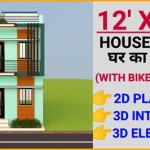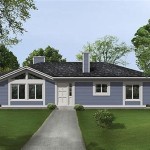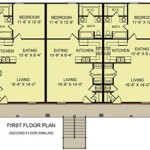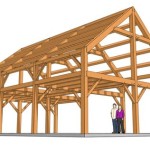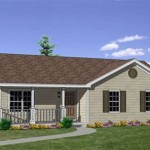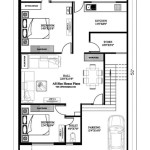House Plans Under 500 Sq Ft: Maximizing Space and Functionality
The concept of a small house, particularly those under 500 square feet, has gained considerable traction in recent years. This shift reflects a growing desire for simplified living, financial prudence, and a reduced environmental footprint. These compact dwellings, often referred to as tiny houses, micro-homes, or accessory dwelling units (ADUs), present unique architectural and design challenges. The primary goal is to optimize every square inch, creating a functional and comfortable living space within limited dimensions. This article explores key aspects of house plans under 500 square feet, covering design considerations, space-saving strategies, and practical examples.
The appeal of building a small house extends beyond mere affordability. The desire to minimize maintenance, reduce utility bills, and embrace a minimalist lifestyle drives many individuals to explore smaller living spaces. Furthermore, smaller homes often require less land, opening up opportunities for construction in urban infill locations or as secondary structures on existing properties. However, successful small house design necessitates careful planning and a deep understanding of spatial optimization principles.
Key Point 1: Space-Saving Design Principles
Maximizing space in a house under 500 square feet requires a deliberate and thoughtful approach to design. Traditional notions of room size and layout must be re-evaluated. Every element, from furniture to storage, must be considered for its dual functionality and space efficiency. Several key principles guide the design process:
Verticality: Utilizing vertical space is crucial. Lofts, high ceilings, and tall shelving units draw the eye upward, creating a sense of spaciousness. Lofts can serve as sleeping areas, reading nooks, or storage spaces, freeing up valuable floor space. High ceilings allow for the installation of customized storage solutions that extend towards the roof, maximizing storage capacity without encroaching on living areas.
Multi-Functional Furniture: Furniture that serves multiple purposes is essential. Sofa beds provide seating during the day and transform into sleeping accommodations at night. Ottoman with built-in storage can serve as footrests, seating, and storage units. Drop-leaf tables can be expanded for dining and folded away when not needed. The intelligent selection of multi-functional furniture can significantly reduce clutter and optimize available space.
Open Floor Plans: Open floor plans combine living, dining, and kitchen areas into a single, unified space. This arrangement eliminates the need for interior walls, creating a more expansive feel. Delineation of functional areas can be achieved through strategic furniture placement, changes in flooring materials, or the use of partial walls or screens. Open floor plans enhance natural light penetration and promote a sense of connectivity within the small home.
Built-In Storage: Incorporating built-in storage solutions throughout the house is vital for efficient organization. Built-in shelving units, drawers under beds, and integrated cabinets maximize storage capacity while minimizing the footprint. Custom-designed storage solutions can be tailored to specific needs and seamlessly integrated into the architectural design, resulting in a clean and uncluttered living environment.
Natural Light and Ventilation: Ample natural light and ventilation can significantly impact the perceived spaciousness of a small home. Large windows, skylights, and strategically placed doors allow natural light to flood the interior, creating a brighter and more inviting atmosphere. Proper ventilation is crucial for air quality and comfort. Cross-ventilation, achieved through windows and doors on opposite sides of the house, helps regulate temperature and humidity.
Scale and Proportion: The scale of furniture and fixtures must be appropriate for the size of the house. Overly large furniture can overwhelm a small space, making it feel cramped and claustrophobic. Opting for smaller-scale furniture and fixtures creates a sense of balance and proportion. Similarly, the placement of large mirrors can create the illusion of greater space and reflect light throughout the room.
Minimalism and Decluttering: Embracing a minimalist lifestyle is essential for successful small house living. Reducing possessions to essential items minimizes clutter and maximizes available space. Regular decluttering and organization are crucial for maintaining a functional and comfortable living environment. Prioritizing quality over quantity and investing in durable, well-designed items can further contribute to a minimalist aesthetic.
Key Point 2: Design Considerations for Different Functional Areas
Designing a house under 500 square feet involves carefully considering the functionality and efficiency of each area. Every zone, from the kitchen to the bathroom, requires a tailored approach to optimize space and meet the needs of the occupants.
Kitchen: In a small house, the kitchen typically comprises a compact cooking area with essential appliances and storage. Choosing smaller appliances, such as a combination microwave convection oven, can save valuable counter space. Vertical storage solutions, like pull-out pantries and hanging organizers, maximize storage capacity. A well-designed kitchen should be efficient and functional, allowing for easy meal preparation and cleanup.
Bathroom: The bathroom in a small house is often a compact space with a shower, toilet, and sink. A corner shower or wet room design can save space compared to a traditional bathtub. Wall-mounted sinks and toilets create a more open feel. Smart storage solutions, such as mirrored cabinets and shelving units, maximize storage capacity without encroaching on floor space. The bathroom should be functional and comfortable, despite its limited size.
Living Area: The living area serves as a central gathering space for relaxation and entertainment. Comfortable seating, such as a sofa bed or loveseat, is essential. A small coffee table or ottoman provides a surface for drinks and snacks. A wall-mounted television or projector can save space compared to a traditional entertainment center. The living area should be inviting and comfortable, providing a space for relaxation and socializing.
Sleeping Area: In many small house designs, the sleeping area is located in a loft to conserve floor space. A comfortable mattress and bedding are essential for a good night's sleep. Adequate ventilation and natural light can enhance the comfort of the loft. Alternatively, a Murphy bed can be incorporated into the living area, providing a sleeping space that can be easily concealed when not in use. The sleeping area should be quiet and dark, promoting restful sleep.
Outdoor Space: Extending the living space to the outdoors can significantly enhance the functionality and appeal of a small house. A small deck, patio, or porch provides an outdoor area for relaxation and entertainment. Outdoor seating, a small table, and potted plants can create a welcoming outdoor living space. Outdoor storage solutions, such as a shed or storage bench, can help keep the interior clutter-free. An outdoor space can significantly expand the perceived living area of a small house.
Key Point 3: Material Selection and Construction Techniques
The choice of materials and construction techniques plays a crucial role in the overall design and functionality of a small house. Sustainable and durable materials are often preferred, along with construction techniques that maximize space and energy efficiency.
Lightweight Materials: Lightweight materials, such as timber framing and SIPs (Structural Insulated Panels), are often used in the construction of small houses. These materials are easy to work with and can reduce construction time. Lightweight materials also minimize the load on the foundation, potentially reducing construction costs. The choice of lightweight materials can contribute to a more sustainable and efficient building process.
Sustainable Materials: Sustainable materials, such as reclaimed wood, bamboo flooring, and recycled content insulation, are increasingly popular in small house construction. These materials minimize environmental impact and promote a healthier indoor environment. Choosing sustainable materials aligns with the principles of eco-friendly living and reduces the carbon footprint of the house.
Energy-Efficient Design: Energy efficiency is a key consideration in small house design. Proper insulation, energy-efficient windows and doors, and a well-sealed building envelope can significantly reduce energy consumption. Passive solar design, which utilizes the sun's energy for heating and lighting, can further enhance energy efficiency. The incorporation of renewable energy sources, such as solar panels and wind turbines, can provide a sustainable source of power.
Prefabrication: Prefabricated construction methods, such as modular construction and panelized construction, can significantly reduce construction time and costs. Prefabricated components are manufactured off-site and then assembled on-site. This approach can result in a more precise and efficient construction process, minimizing waste and reducing the impact on the surrounding environment.
Foundation Options: Small houses can be built on various foundation types, including concrete slabs, pier and beam foundations, and trailer foundations. The choice of foundation depends on the site conditions, local building codes, and the intended use of the house. Trailer foundations are common for mobile tiny houses, while concrete slabs and pier and beam foundations are more suitable for permanent structures. The foundation should be durable and stable, providing a solid base for the house.
Building Codes and Regulations: Building codes and regulations vary depending on the location of the house. It is essential to research and comply with all applicable codes and regulations before beginning construction. Some jurisdictions have specific regulations for tiny houses, while others may require adherence to standard building codes. Compliance with building codes ensures the safety and durability of the house.
Effective house plans under 500 square feet require a blend of innovative design, space-saving solutions, and careful attention to detail. By embracing these principles, it's possible to create smaller homes that are both functional and aesthetically pleasing.

500 Square Foot Smart Sized One Bedroom Home Plan 430817sng Architectural Designs House Plans

Single Bedroom House Plans With Staircase Under 500 Sq Ft For 120 Yard Plots Small Hub

500 Sq Ft House Plans Small Floor

Image Result For 500 Sq Ft House Plans 1 Bedroom Small

500 Square Feet House Plan Construction Cost Acha Homes

Life In A Tiny Home Small House Plans Under 500 Sq Ft

Single Bedroom House Plans With Staircase Under 500 Sq Ft For 120 Yard Plots Small Hub

High Resolution House Plans Under 500 Square Feet 7 Small Sq Ft Tiny Floor

Plan 76166 Tiny Floor Under 500 Sq Ft Has 2 Bedrooms And 1

500 Square Feet Home Design Ideas Small House Plan Under Sq Ft


